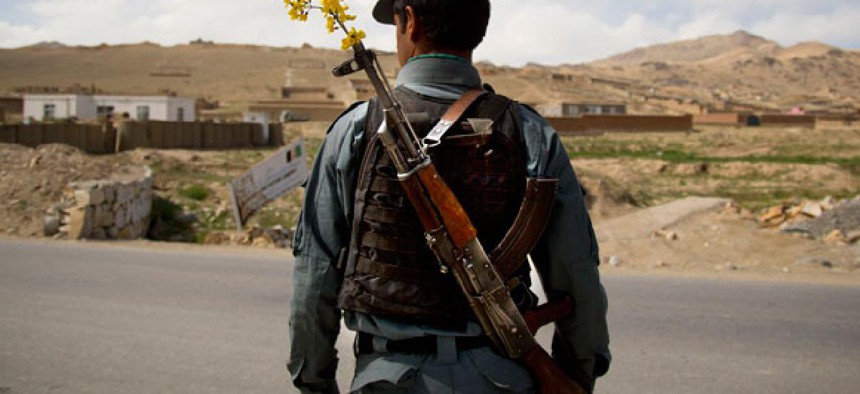
An Afghan National Police officer watches over a checkpoint Anja Niedringhaus/AP
How the Afghan Conflict Will Be Decided
More U.S. casualties reaffirm Obama’s rush to rely on the Afghan army. Can they handle it?
KABUL, Afghanistan – Gen. Sher Mohammad Karimi thumbs excitedly through a brochure prepared for him by Textron, the U.S. defense contractor. “This is what I want!” the Afghan army chief of staff says, pointing to a picture of the latest technology in armored troop carriers.
Outside Karimi’s window, the giant, $92 million new defense headquarters that Washington is building for him is nearly finished; Karimi moves in in September. “Pentagon No. 1. This no. 2,” Karimi’s adjutant, Col. Mohammed Shah, says proudly in broken English. What Shah means is that the vast domed structure atop a hill—which resembles nothing so much as the Temple Mount—is expected to be the second-largest defense headquarters in the world, a distinct oddity in one of the poorest countries in the world. The Pentagon is also spending about a billion dollars on Karimi’s pride and joy, a new Mobile Strike Force. That includes $58 million on brand-new armored vehicles designed especially for the Afghan army by Textron (and which are deemed so state of the art that Canada just bought some for itself).
More than anywhere else, the future of Afghanistan will be decided here, in the heart of the new Afghan security structure on which Washington is spending billions of dollars. And it may well be decided in the next six or seven months, when the latest “fighting season” ends and the mettle of Karimi’s new Afghan National Security Forces are truly tested. As of the end of June, the ANSF will move from planning and leading operations for the entire country. Asked in an interview what his plan was for defeating the Taliban, Karimi replied: “We will never allow the Taliban to take over the country. That’s the plan.”
It doesn’t sound like much of a plan, but Karimi had better be right. This has been a horrific week for U.S. casualties, culminating in a suicide bombing in Kabul on Thursday that killed six Americans and at least nine other people. The casualties, which included the deaths of four U.S. soldiers killed by a roadside bomb near Kandahar on Tuesday, will almost certainly harden President Obama’s commitment to hand this decade-long quagmire over to the ANSF as quickly as possible.
Like other Afghan and U.S. military officials, Karimi says the 334,000-strong ANSF are far stronger and more organized than they have ever been, reducing the insurgency to nighttime raids and occasional IED and suicide bombings. “We have kept, and protected, all the areas we are responsible for,” Karimi says. U.S. and Afghan officials now describe the Taliban as “confused” about their strategic aims, though the insurgents are not ready to talk peace, by all accounts.
Still, the Taliban-led insurgency, said to consist of no more than about 30,000 fighters, has made much of the country too dangerous to travel. And Thursday’s bombing points up the complex nature of the enemy, whose leaders perceive how quickly support for the war is fading in the U.S. and NATO countries and aims to launch “spectacular” attacks like Thursday’s to quicken the departure of the 50-nation International Security Assistance Force, which consists of 28 NATO and 22 non-NATO countries and is led by the United States. The American victims were two soldiers and four civilian contractors, a NATO source said. An extremist group called Hezb-e Islami under the Pakistan-based warlord Gulbuddin Hekmatyar claimed responsibility for the attack. A former Afghan prime minister, Hekmatyar is not part of the Taliban but occasionally fights alongside them—and sometimes against them. Other attacks have been blamed on various factions that are also supplied out of Pakistan, especially the notorious Haqqani network, which is also loosely allied with the Taliban.
Whoever this multifaceted enemy really is now, it’s increasingly apparent that most of the hardest fighting will still be left to the Afghans and Americans. For that, Karimi says he’s going to need a lot of U.S. military assistance well after the end of 2014, the deadline for withdrawal. “We still need their help and support, maybe for another five to 10 years,” he says. Lt. Gen. Nick Carter, the deputy commander of ISAF under Marine Gen. Joseph Dunford, tends to back Karimi’s assessment. “For some time to come it’s our expectation that we will need to supply the Afghans ... [with] air support, certainly, counter-IED support, logistic support, and a number of areas where their capabilities are not at the level where they need to be at,” Carter said in an interview last Saturday. He says the U.S. and NATO will have to “train, advise, and assist”—the post-2014 catchphrase—probably until at least 2018.
But those plans are barely sketched out. U.S. and European officials interviewed here this week appeared to agree on one thing: Most of ISAF is waiting on Obama, whose administration is currently engaged in secret negotiations with Karzai’s government on the size and shape of the U.S. force that will be left in Afghanistan after the final drawdown of the 63,000 or so American troops that remain.
That force is expected to number perhaps 8,000 troops, complemented by another 4,000 or so from NATO and ISAF countries. But France and Canada have already announced they are leaving Afghanistan completely, and thus far only Germany has stepped up with an offer of 600-800 troops post-2014.
Can it work? “As we are tired of fighting, so are the Taliban,” insists Karimi, who was interviewed before Thursday’s attack. “They are not united. They have different approaches. Pakistan is supporting the Taliban, but Pakistan has its own [economic] problems. So it is not easy for Pakistan to continue sustaining them." Indeed, despite all the negative trends here now—enemy attacks may well be up, one reason NATO doesn’t even track them anymore—Thursday’s assault on the convoy was a rare “spectacular” in recent months. “The Taliban have more propaganda than actually what they can do,” said Karimi. “They announced [their spring offensive] and started it about two weeks ago. So where is it?”
Well, it’s still here, as a horrific week has demonstrated. Karimi may be right that the Afghan army will hold the center of the country, and that the Taliban are no longer taking over and holding large sections of Afghanistan. The ANSF now outnumbers the Taliban by 10-to-1. Even in the face of U.S. and NATO withdrawal, the long-term commitments Washington and other capitals are making, however reluctantly, will very possibly change the age-old equation that has often seemed to doom Afghanistan to a state of permanent war.
But it still promises to be a very long haul, no matter how much money and effort America pours into the new Afghan army.







